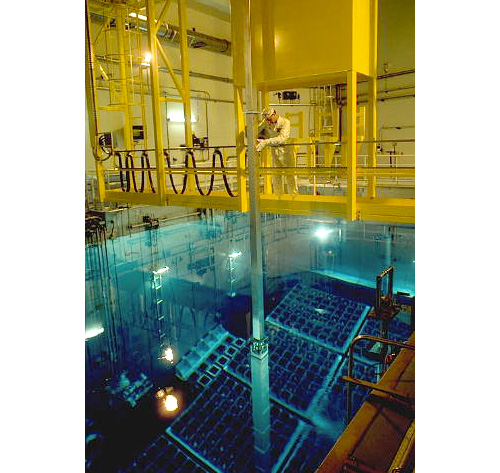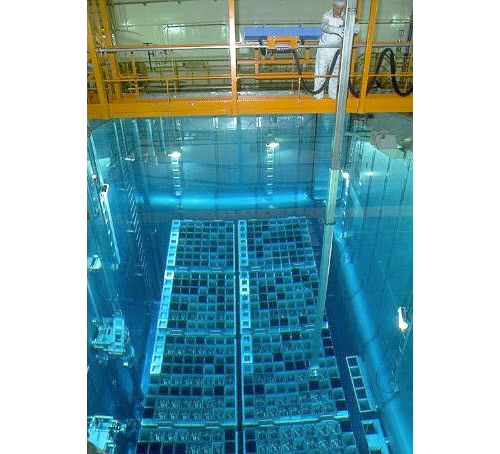Fuel unloading and initial pool storage of spent fuel
The fuel load in a conventional pressurised water reactor (PWR) lasts around three years. During this period, the fissile elements in the fuel are depleted and the fuel is enriched with fission products, some of which play a poisoning role. After three years, the spent fuel must be replaced with fresh fuel. Rather than replacing all the fuel at the same time, one third is replaced each year.

Unloading spent fuel assemblies
Fuel assemblies removed from a reactor core during the shutdown of a unit of the Golfech power plant. The assemblies are stored for at least a year in an adjacent pool. Loading and unloading operations are carried out underwater. The water absorbs the heat released by the fuel and provides effective radiation shielding. The characteristic blue colour of the water is due to the Cherenkov lighting effect, which occurs as electrons are emitted by beta disintegration.
© EDF MEDIA ARCHIVE / RAYMOND de SEYNES
Fuel is unloaded with the reactor shut down, with the reactor cooling system depressurised and the reactor vessel open. The operation takes place underwater. Fuel assemblies are transferred from the reactor core to the reactor cavity and then to the spent fuel pit. The role of the water is to protect operators and cool the fuel. During the operation, any fuel assemblies that leak as a result of cladding rupture are detected. Defective fuel assemblies are stored in sealed casks pending specialised processing.
When the fuel is unloaded, it contains extremely radioactive short-lived radioelements (radioactivity is inversely proportional to half-life) that release large quantities of heat. Conversely, these more highly radioactive products disappear during storage. For example, an element with a half-life of 10 days will have decayed by a factor of 200,000 after 6 months.

Fuel building pool of a PWR reactor
The pool of the fuel building at the Chooz B1 plant in Champagne-Ardennes. This pool contains new fuel elements awaiting loading as well as unloaded elements, which are stored in it for a few years, where they cool before being sent for reprocessing in La Hague plant. In this photo, the storage compartments contain only new fuel elements, as the photo was taken in 1995 during the initial fuel loading of the Chooz B1 reactor.
© EDF MEDIA ARCHIVE / PIERRE BERENGER
Irradiated assemblies are stored for at least a year in the spent fuel pit, which is generally located adjacent to the reactor and is also used when loading new fuel. Water has a high heat capacity and readily absorbs released heat. It also provides effective radiation shielding. Radiation breaks down water molecules but does not render the hydrogen and oxygen atoms radioactive. The water in the pool has a characteristic blue colour: certain beta electrons travel faster than light through water, emitting photons with a bluish tinge. This effect is known as Cherenkov light.
After an adequate period in storage, the radioactivity in the waste decays sufficiently to allow subsequent operations. After a year, the fuel’s activity level falls to around 2 million curies per tonne. Although still very high, this activity level is compatible with transport to a reprocessing plant. Spent fuel assembly handling operations are robotised.
Non-reprocessed fuel assemblies may remain in storage in the spent fuel pit for decades or more, pending final decisions regarding appropriate final disposal.
Other articles on the subject « Spent nuclear fuel »
Spent fuel Burn-up
Irradiation rate and energy supplied by fuel The energy produced by a nuclear power plant is prop[...]
Spent fuel composition
Key figures on spent fuel composition The composition of irradiated fuel removed from a reactor c[...]
Waste radioactivity decrease
A natural but slow decay process As natural radioactivity progressively decays, the radioactivity[...]
Spent fuel decay heat
Significant, slow-to-decline heat release The heat released by radioactive disintegration is a ke[...]
Spent fuel radiotoxicity
A risk indicator more pessimistic than radioactive activity Radioactivity is an imperfect descrip[...]